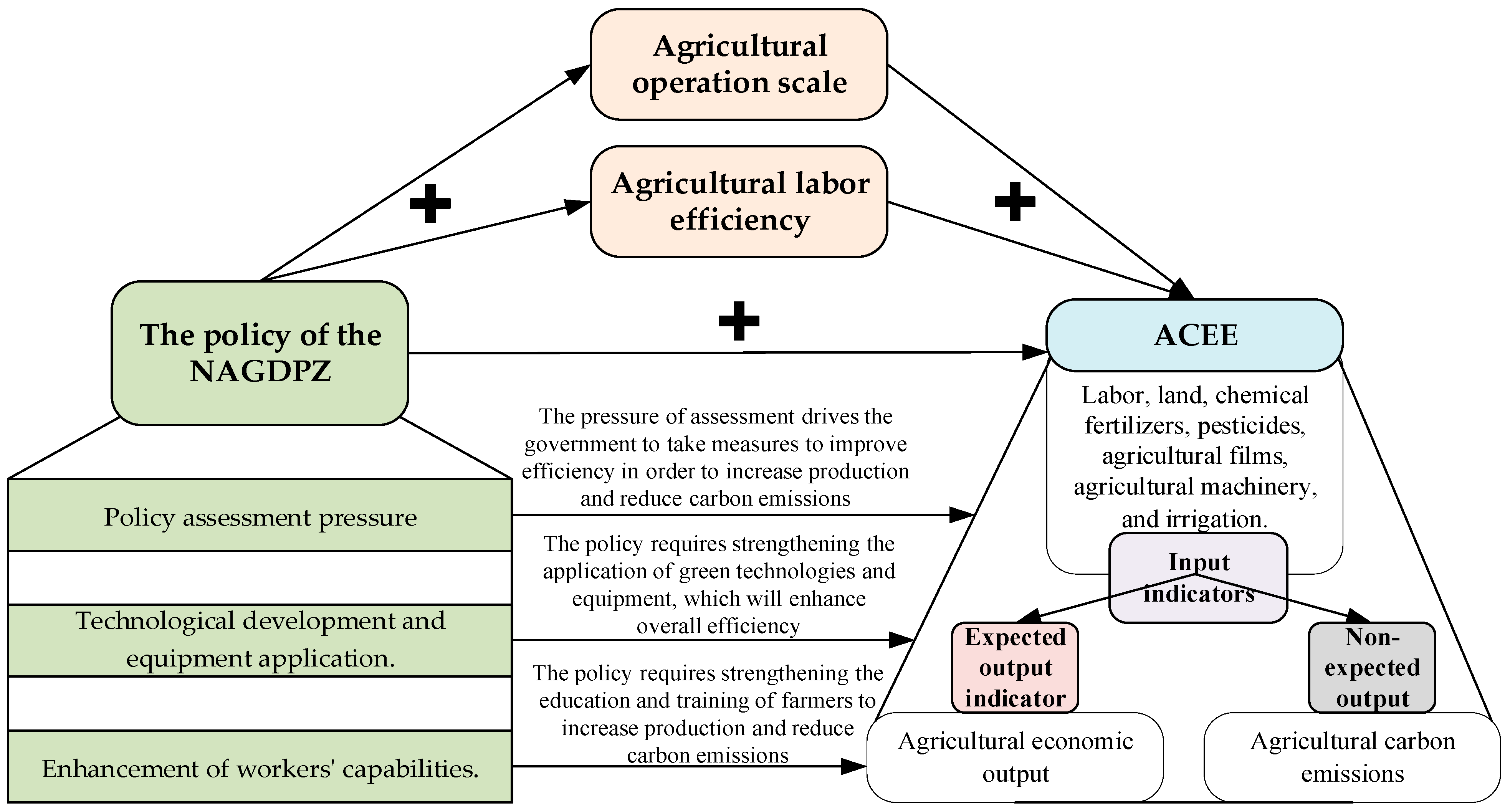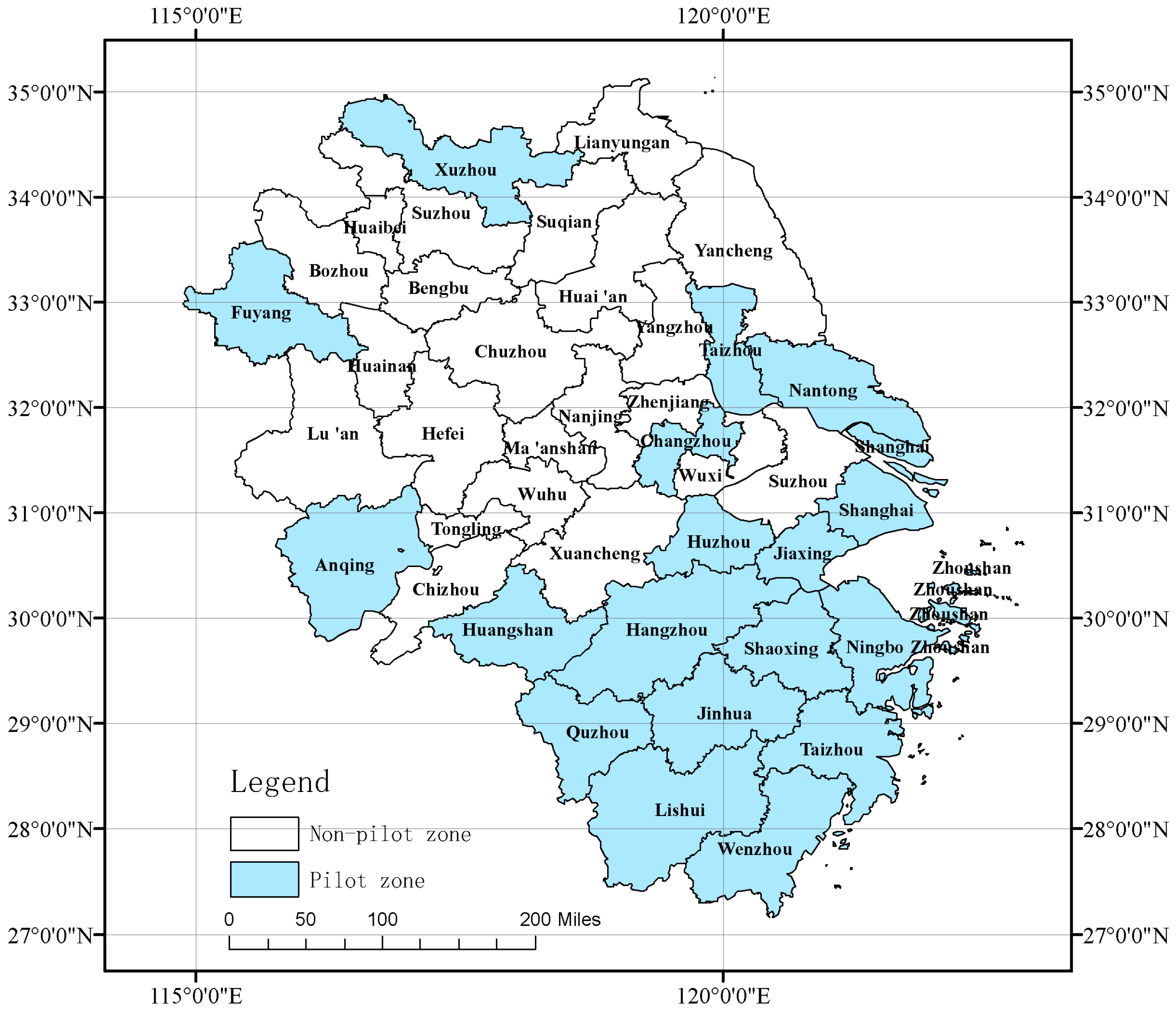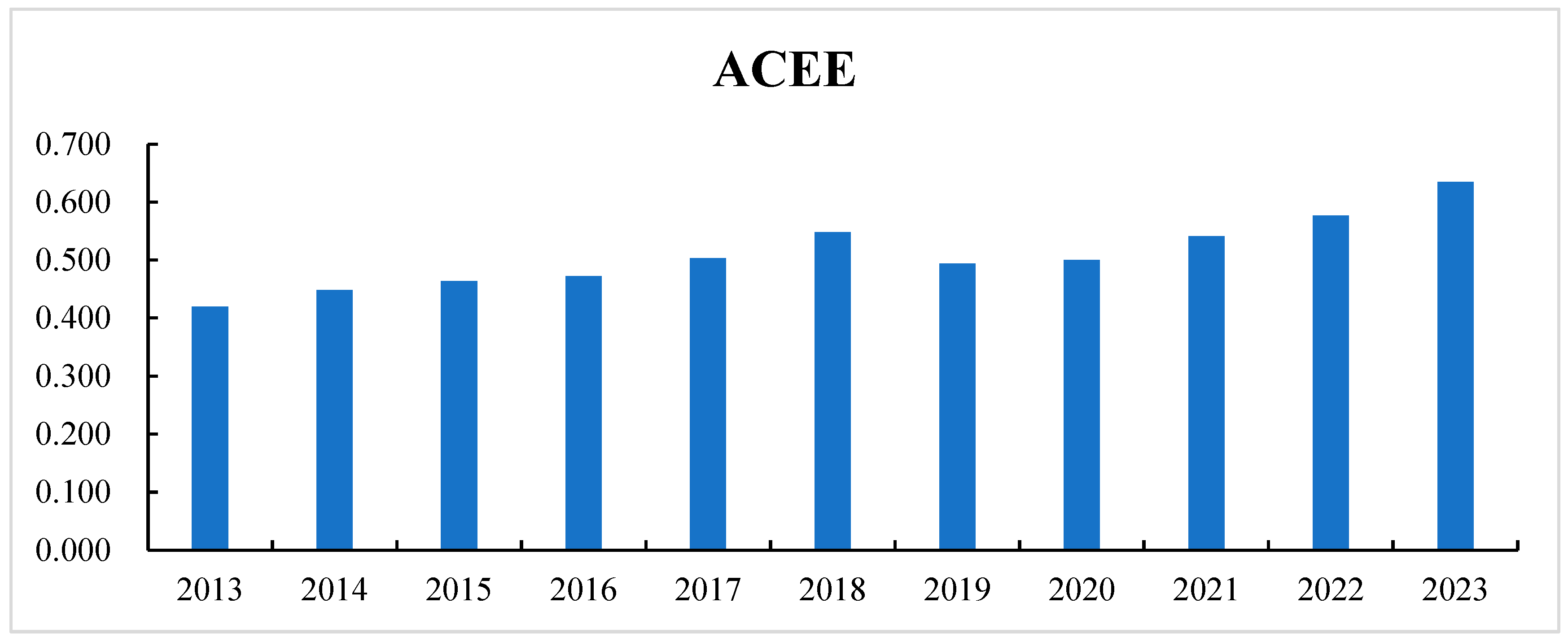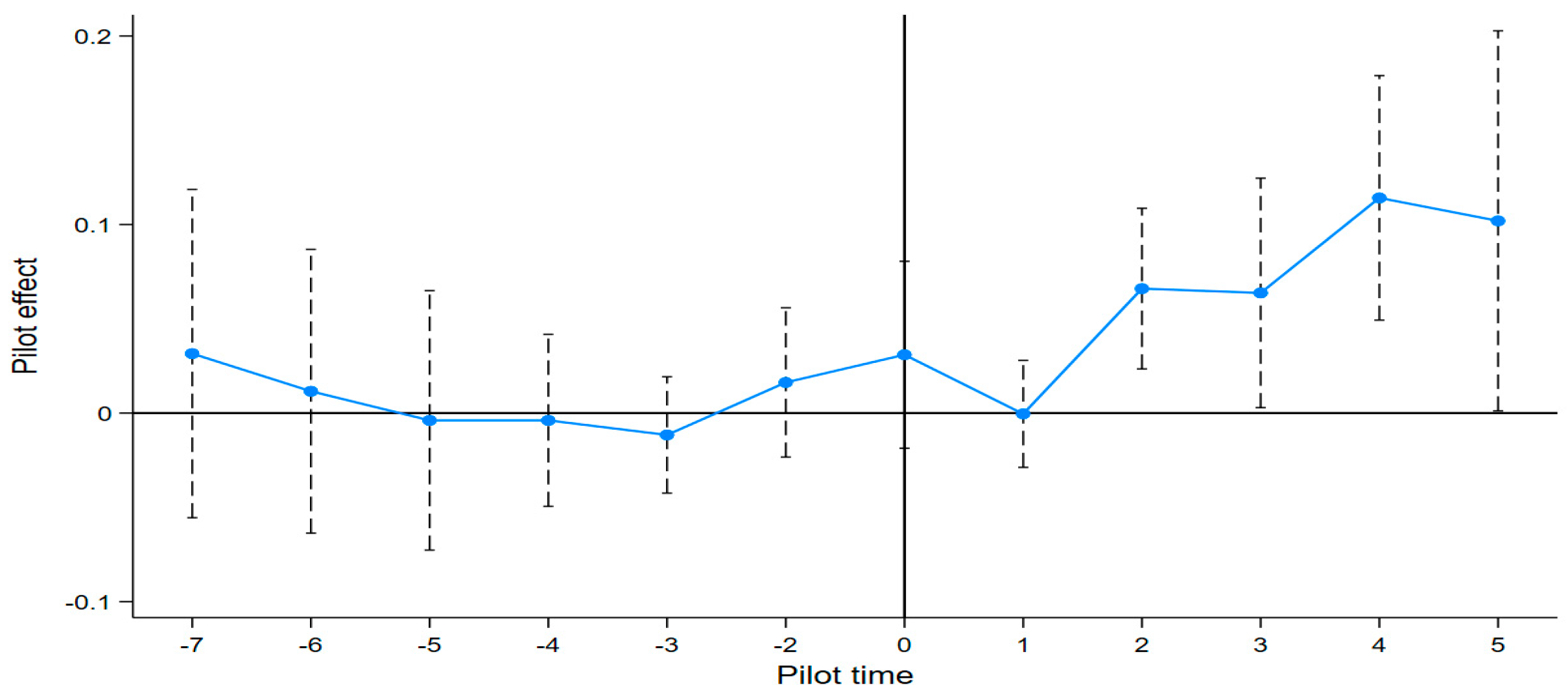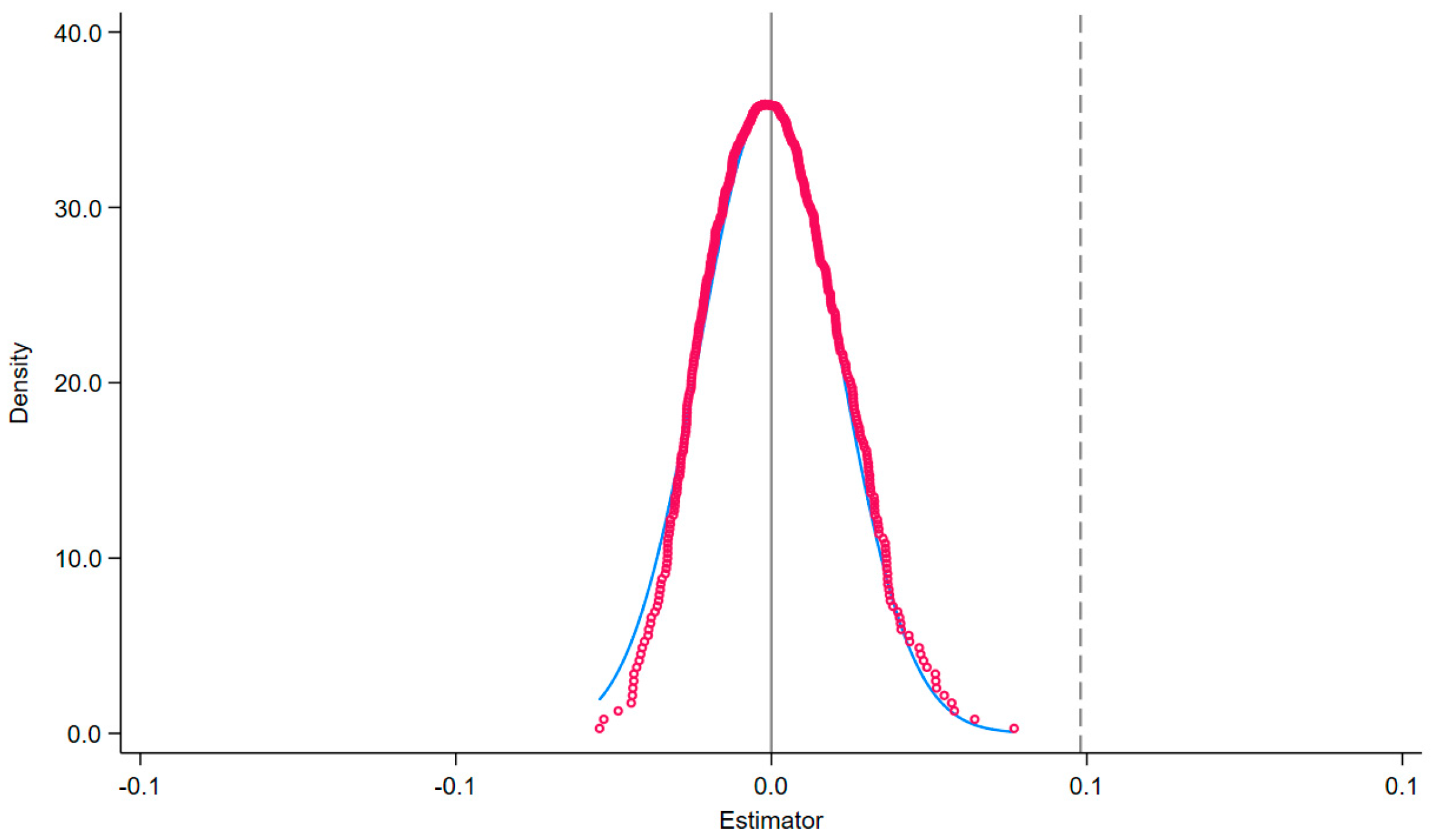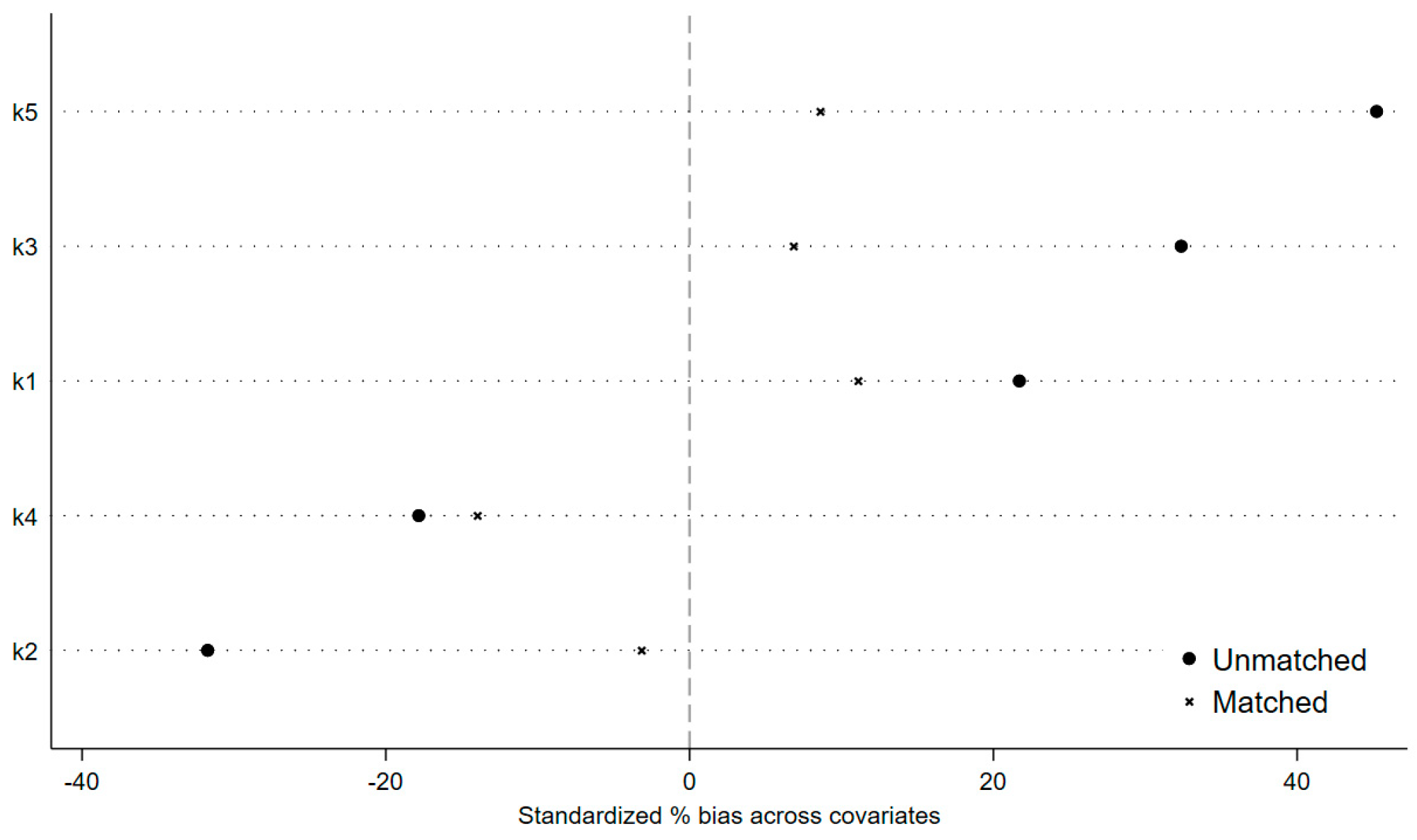1. Introduction
Agricultural Carbon emissions (ACEs) account for more than 20% of the total global carbon emissions [
1,
2] and have become an important issue for the sustainable development of mankind. China is a developing country and also a major agricultural country. During its development process, a considerable amount of ACEs have been generated [
3,
4]. Reducing ACEs has become an important part of China’s agricultural modernization. Improving carbon emission efficiency is the main way to effectively reduce ACEs and promote high-quality agricultural development [
5,
6]. Improving the ACEE is of great significance to China. The NAGDPZ is a large-scale pilot project in China that aims to promote the GDA [
7]. Its aim is to promote agricultural economic development while reducing various agricultural pollutions, including ACE, and enhancing the capacity for GDA. Analysis of the impact of the NAGDPZ on ACEE can provide realistic evidence for the evaluation of the environmental benefits of this policy. However, at present, there are relatively few studies addressing this aspect.
ACEE has received high attention from scholars. Existing academic literature mainly focuses on the definition, calculation, and influencing factors of the ACEE for analysis. The definition of ACEE reflects the ideal minimum ACEs or maximum output under given input–output conditions and can reflect the level of agricultural productivity under ACE constraints [
8]. When the ACEE improves, it results in the growth of the agricultural economy or a reduction in ACEs under the same input [
9]. In terms of the calculation of ACEE, some scholars use the ratio of the GDP output level per unit of carbon dioxide in agriculture to measure ACEE [
10]. However, more scholars measure the efficiency by constructing the index system of ACEE. The main calculation models are data envelopment analysis (DEA) models (for example, the non-expected output super slacks-based measure (N-S-SBM) model) [
11,
12,
13,
14,
15,
16]. In addition, the combination of these DEA models and the Malmquist index model represents an important method for calculating ACEE [
17,
18]. In terms of influencing factors for ACEE, factors such as economic development [
19], changes in rural population structure [
20], urbanization [
21], integrated urban–rural development [
22], grain subsidy [
23], technological innovation [
24], digital inclusive finance [
9], and digital economy [
25] will all have an impact on ACEE. In the system of influencing factors for ACEE, government policies are an important component. Existing research indicates that government policies have a significant impact on ACEs [
26], and green agricultural development policies are crucial for reducing ACEs [
27]. Existing studies have analyzed the roles of policy-based agricultural insurance [
28], the “village consolidation and resettlement” policy [
29], the smart agriculture policy [
30], the farmland leasing policy [
31], and the high-standard farmland construction policy [
32] in ACEs and ACEE. Furthermore, existing studies have also pointed out that pilot policies oriented towards promoting green development will have a positive impact on carbon emissions [
33,
34]. Some studies have also explored the reduction effect of pilot policies such as the big data comprehensive experimental zone policy [
35] on ACEs. It can be seen that the research on ACEE is very rich, which provides scientific support for improving ACEE. In particular, research on the impact of various agricultural policies on ACEE reveals the important role of policies. However, it should be noted that existing research rarely specifically discusses the role of agricultural green development policies such as the NAGDPZ in ACEE.
The NAGDPZ has also seen some studies explore the role of this policy in the agricultural ecological environment. For example, Gao et al. [
7] took Zhejiang and Jiangsu provinces as research areas and analyzed the NAGDPZ policy’s impact on the government’s activities supporting environmental protection. The results showed that after the implementation of the policy, the investment of local governments in Zhejiang Province in environmental protection increased. Yao et al. [
36] analyzed the impact of the NAGDPZ policy on the green total factor productivity of agriculture (AGTFP). They pointed out that the implementation of this policy pilot significantly improved the AGTFP by enhancing technical efficiency. Li et al. [
37] took Hubei Province as a research area and analyzed the impact of the NAGDPZ policy on agricultural ecological efficiency (AEE). The analysis found that the NAGDPZ policy enhanced AEE, and agricultural innovation was an important mediating variable enabling the policy to play its role. Existing research has demonstrated the positive effects of the NAGDPZ policy on the agricultural ecological environment, providing practical evidence for the in-depth implementation and further promotion of this policy, and holds academic and practical value. However, at present, there are still relatively few studies on the impact of the NAGDPZ policy on ACEE, and the above-mentioned studies are not specifically focused on ACEE. This imposes certain constraints on the improvement in ACEE.
The YRD region has received high attention from the academic community [
38,
39,
40]. The YRD region is facing increasing pressure from human activities and the ecological environment [
41,
42], and its agricultural ecological environment is also facing severe challenges [
43,
44]. The development of agriculture urgently needs green transformation [
45]. Meanwhile, the YRD region is also an important area of the NAGDPZ. It includes Zhejiang Province, which has been selected as an NAGDPZ [
7], as well as two major grain-producing areas, Jiangsu and Anhui, and Shanghai, a municipality directly under the central government that has been selected as an NAGDPZ. Therefore, exploring the impact of the NAGDPZ policy in the YRD region on ACEE can not only provide scientific support for agricultural green development in this key area but also offer references for the implementation of the NAGDPZ policy in other regions of China. It is also conducive to providing a reference for the implementation of agricultural green development policies in other countries around the world. However, existing research has not systematically discussed the ACEE of the YRD region specifically in terms of the NAGDPZ. This is not conducive to effectively improving the ACEE and reducing ACEs in this region.
This study analyzes the influence of the NAGDPZ policy on ACEE and further explores its influencing mechanisms. The contributions of this article are as follows: (1) Through comparison with existing studies on the factors influencing ACEE, this study explores the role and mechanism of the NAGDPZ policy on the ACEE, which has been less analyzed in existing studies, and further enriches the system used to analyze the ACEE’s influencing factors. (2) Compared with existing research on the NAGDPZ, this study expands current knowledge. For example, the main goal of the research of Gao et al. [
7] and Yao et al. [
36] was to explore the role of the establishment of the NAGDPZ in environmental input and AGTFP, without considering the issue of ACEs. Although Li et al. [
37] took ACEs into account in the calculation of AEE, there are differences when compared with this study in terms of the research area, index setting, and mechanism of action. Moreover, one is an analysis at the urban level, and the other is an analysis at the county level. This study will provide a new perspective on NAGDPZ research. (3) In terms of theory, this article provides new empirical analysis support for environmental regulation theory, verifies the positive significance of composite environmental regulation for the low-carbon development of agriculture (LCDA), and at the same time, theoretically reveals the mechanism by which the NAGDPZ policy enhances the expansion of AOS and the improvement of ALP in ACEE.
The purpose of this article is to discuss the impact of the NAGDPZ policy on ACEE, thereby providing some suggestions for the implementation of this policy and offering references for improving ACEE so as to promote LCDA. The main structure of this article is as follows:
Section 2 contains a theoretical analysis and outlines the hypotheses, offering theoretical discussions on the impact of the NAGDPZ policy on ACEE and its mechanism.
Section 3 covers the research area, model setup, and data sources.
Section 4 provides an empirical analysis, using the results to prove the hypotheses and elucidate the robustness of the analytical content.
Section 5 is a discussion, mainly focusing on the value of the research results and their relationship with existing achievements.
Section 6 details the conclusion and policy recommendations.
5. Discussion
Research on the factors influencing the ACEE is a well-established topic, but few scholars have explored the impact of the NAGDPZ policy on ACEE. This study aimed to fill this gap, identifying the positive role of the NAGDPZ policy on ACEE and exploring its mechanism of action. This study is an expansion on current academic research.
The YRD region is an important area for agricultural development in China and is confronted with severe agricultural ecological and environmental problems [
43,
44]. The establishment of the NAGDPZ has effectively enhanced the ACEE in this region, promoted the green growth of agriculture, and achieved positive results. This is similar to the positive effects of the NAGDPZ policy demonstrated by Gao et al. [
7], Yao et al. [
36], and Li et al. [
37] on agricultural environmental protection input, AGTFP, and AEE. Of course, this study has certain differences from these studies in terms of research topics, research areas, and influencing mechanisms. However, it is precisely the existence of such differences that enables this study, together with the above-mentioned studies, to jointly demonstrate the positive effect of the NAGDPZ policy on the agricultural ecological environment, providing realistic evidence for the in-depth implementation of this policy pilot.
The positive effect of the NAGDPZ on ACEE indicates that the implementation of agricultural sustainable development policies or corresponding pilot projects has positive significance for the LCDA. Other regions in China and other developing countries around the world can draw on this practice, accelerate the implementation of green agricultural development policies, and carry out various regional pilot projects conducive to agricultural pollution control so as to accelerate the sustainable development of agriculture. However, it should be recognized that the implementation of the NAGDPZ policy relies on sufficient financial support. Whether it is the innovation and application of agricultural low-carbon technologies, the use of green agricultural machinery, or the education and training of farmers, all require financial support. However, some regions in China may lack sufficient financial funds to facilitate the efficient implementation of this policy. This requires these regions to obtain the support of the central government of China and economically developed regions, and at the same time accelerate social financing. Furthermore, some developing countries elsewhere in the world are even more lacking in funds. Their agricultural foundation and level of LCDA in the early stage may also be relatively poor. How to obtain sufficient funds to carry out pilot projects for green agricultural development is an important issue restricting the GDA and LCDA of some developing countries.
6. Conclusions and Policy Recommendations
6.1. Conclusions
The establishment of the NAGDPZ has an impact on ACEE. However, there are few existing studies analyzing this topic, and thus they cannot fully demonstrate the positive role of the NAGDPZ policy. This study conducted a systematic analysis of the policy’s impact on ACEE and found the following:
(1) The overall ACEE in the YRD region has improved, and the spatial distribution is higher in the southeast and lower in the northwest. The average ACEE in the YRD region has increased from 0.420 in 2013 to 0.635 in 2023, an increase of 51.295%. In terms of spatial distribution, the ACEE in the northeastern part of Anhui Province is relatively low, while that in the areas surrounding Shanghai is relatively high.
(2) The NAGDPZ policy can significantly enhance ACEE. The impact of the NAGDPZ policy on ACEE is significantly positive at the statistical level of 10%, with a coefficient of 0.049. This positive influence effect still holds after many robustness tests such as the parallel trend test, placebo test, PSM-DID analysis, and exclusion of the influence of other policies.
(3) The NAGDPZ policy enhances ACEE by expanding the AOS and improving ALP. The NAGDPZ policy has a significant positive impact on the AOS and ALP, with coefficients of 0.052 and 0.061, respectively. The improvement in the AOS and ALP is conducive to enhancing ACEE.
6.2. Policy Recommendations
(1) The NAGDPZ policy can significantly enhance the ACEE. Therefore, it is suggested that one expands the scope of the NAGDPZ and includes more regions in the construction of the pilot zone. The YRD region should actively represent the experience of creating an NAGDPZ and drive the low-carbon transformation of agriculture in the Yangtze River Economic Belt and other regions, ultimately enhancing ACEE.
(2) The NAGDPZ policy enhances ACEE by expanding the AOS. To this end, it is suggested that one accelerates the confirmation and certification of land rights, improves the rural land leasing market, and promotes the transfer of agricultural land to provide land support for moderate-scale agricultural operations; in addition, we suggest promoting the popularization of low-carbon agricultural technologies and green mechanical equipment that match the level of moderate-scale operation so as to enhance agricultural output under the background of moderate-scale operation and to reduce ACEs.
(3) The NAGDPZ policy enhances ACEE by improving ALP. To this end, it is suggested that one continues to strengthen the training and education of farmers through online teaching, sending experts to rural areas and using other means, to further improve ALP; in addition, we suggest building an external talent pool and making full use of local talents working outside to provide guidance for the construction of the NAGDPZ, enriching human capital.
Of course, due to the limitations of this study, there are still some deficiencies that need to be improved further: (1) This study only conducted research on the YRD region, while the NAGDPZ policy has been implemented nationwide, and its impact on the ACEE in other regions still needs to be analyzed. This represents a future research direction. (2) This study only explored the mechanisms of AOS expansion and ALP improvement in the NAGDPZ policy’s impact on the ACEE. Other influencing mechanisms have not yet been analyzed and need to be addressed in the future.
